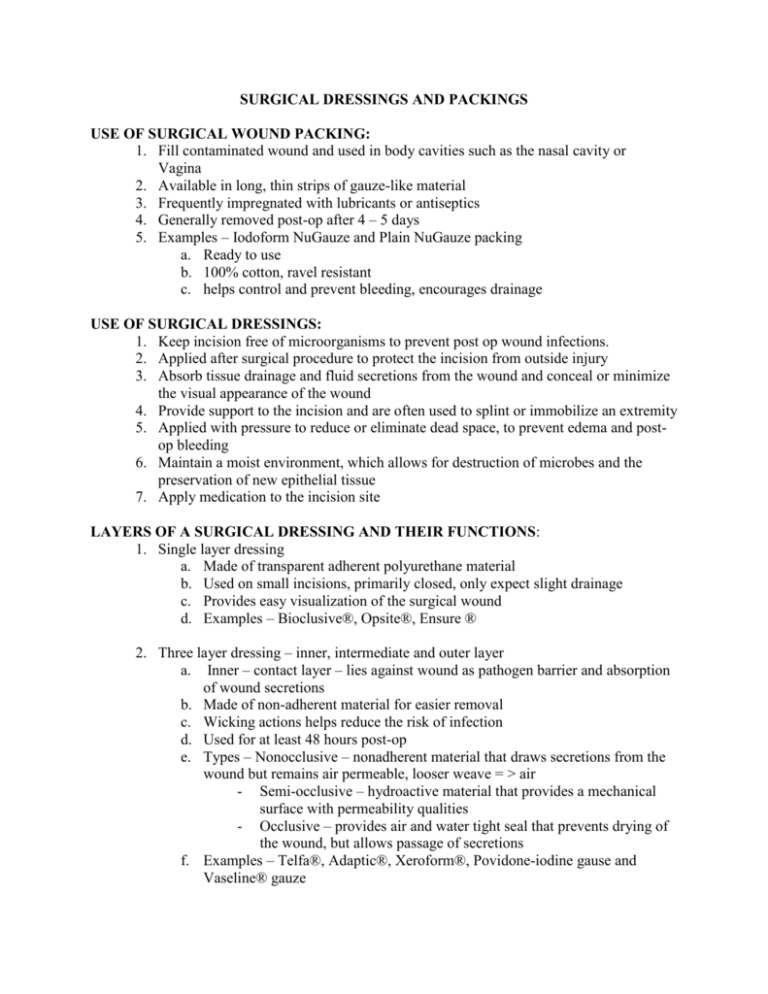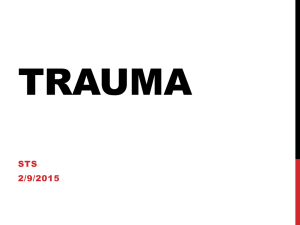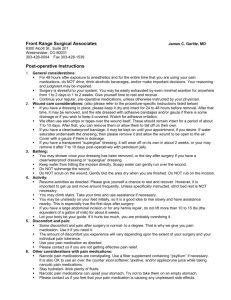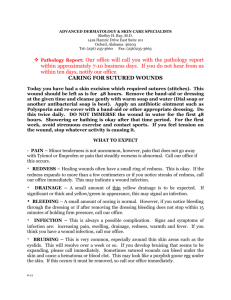SURGICAL DRESSINGS AND PACKINGS USE OF SURGICAL
advertisement

SURGICAL DRESSINGS AND PACKINGS USE OF SURGICAL WOUND PACKING: 1. Fill contaminated wound and used in body cavities such as the nasal cavity or Vagina 2. Available in long, thin strips of gauze-like material 3. Frequently impregnated with lubricants or antiseptics 4. Generally removed post-op after 4 – 5 days 5. Examples – Iodoform NuGauze and Plain NuGauze packing a. Ready to use b. 100% cotton, ravel resistant c. helps control and prevent bleeding, encourages drainage USE OF SURGICAL DRESSINGS: 1. Keep incision free of microorganisms to prevent post op wound infections. 2. Applied after surgical procedure to protect the incision from outside injury 3. Absorb tissue drainage and fluid secretions from the wound and conceal or minimize the visual appearance of the wound 4. Provide support to the incision and are often used to splint or immobilize an extremity 5. Applied with pressure to reduce or eliminate dead space, to prevent edema and postop bleeding 6. Maintain a moist environment, which allows for destruction of microbes and the preservation of new epithelial tissue 7. Apply medication to the incision site LAYERS OF A SURGICAL DRESSING AND THEIR FUNCTIONS: 1. Single layer dressing a. Made of transparent adherent polyurethane material b. Used on small incisions, primarily closed, only expect slight drainage c. Provides easy visualization of the surgical wound d. Examples – Bioclusive®, Opsite®, Ensure ® 2. Three layer dressing – inner, intermediate and outer layer a. Inner – contact layer – lies against wound as pathogen barrier and absorption of wound secretions b. Made of non-adherent material for easier removal c. Wicking actions helps reduce the risk of infection d. Used for at least 48 hours post-op e. Types – Nonocclusive – nonadherent material that draws secretions from the wound but remains air permeable, looser weave = > air - Semi-occlusive – hydroactive material that provides a mechanical surface with permeability qualities - Occlusive – provides air and water tight seal that prevents drying of the wound, but allows passage of secretions f. Examples – Telfa®, Adaptic®, Xeroform®, Povidone-iodine gause and Vaseline® gauze g. Telfa – non-adhesive pads – soft, perforated film that enables air to circulate while the sterile cotton pad absorbs fluid h. Xeroform petrolatum dressing – impregnated with medication in a petrolatum blend; sterile, mildly deodorizing astringent. i. Vaseline – impregnated with white petrolatum for nonadherence, sterile bandage and dressing in one protects wound from contamination 3. Intermediate layer – absorbent layer, which holds the secretion passing through the inner layer, reducing the chance of infection a. Acts as a cushion to protect the wound from further trauma b. Should not apply pressure that could compromise circulation c. Examples – 4 x 4 gauze, ABD pads, roller gauze, Kling®, Kerlix®, stockinette, cotton padding d. SURGIPAD – Combine dressing = ABD – multilayer abdominal dressing provides protection and padding for major wounds with maximum absorbency, wicking and dispersal of wound exudates e. Kling – gentle stretch bandage, conformability and selfadherence necessary for dressing hard to bandage areas. f. Kerlix – special design for bandaging heads, limbs and difficult to dress wounds. Prewashed, fluff dried roll, 6 ply gauze with finished edges. 4. Outer – binding or supportive layer – holds inner and intermediate layers in proper position a. Should conform to body or extremity and elastic enough to allow for swelling of incision or extremity b. Examples – Ace bandages, Coban, tube gauze, cast materials, adhesive and hypo-allergenic tapes such as: silk, paper, foam, elastoplast, plastic or cloth c. ACE – elastic bandage – yarn reinforced with rubber provide stretch and compression d. COBAN – self adherent wrap – stays in place without slipping e. MICROFOAM surgical tape – Elastic foam tape for compression SPECIALITY DRESSINGS: 1. MONTGOMERY STRAPS- Accessory abd dressing, holds bulky dressings in place, prevents skin injury from repeated application and removal of skin tape 2. STENT DRESSING – applies pressure to prevent hematoma formation and stabilizes tissue such as skin grafts, provides form fitting mold over long, strategically placed sutures, crisscrossed over a small dressing and tied securely 3. PRESSURE DRESSING – eliminates dead spaces, prevents edema and hematoma, even pressure while supporting and immobilizing, provides comfort 4. THYROID DRESSING – collar dressing, secured by wrapping bandage around neck and crisscrossed over a small dressing and tied securely 5. DRAIN DRESSING – used post op to absorb drainage, nonadherent dressing can be used as contact layer around drain, can be “Y” cut shape to fit around base of drain, Pre-cut drain dressings available. 6. COLLODIAN SPRAY, LIQUID, GEL – chemical dressing used to form thin barrier over wound when little or no drainage expected, washes or wears off after several days, used frequently for minor or plastic surgery incision 7. OSTOMY BAG – used when a stoma has been created - colostomy/ileostomy 8. MISCELLANEOUS – aerosol adhesive sprays, foams, gels and hydrocolloids. BENZOIN spray. APPLICATION OF A SURGICAL DRESSING: 1. Application of sterile surgical dressing is considered part of the surgical procedure. 2. The surg tech and circulator assist the surgeon to dress the wound properly 3. Circulator opens the sterile dressing after the final count 4. Skin surround incision cleaned of blood and debris with damp sponge. 5. Surgeon, first assist, surg tech, dons a clean pair of sterile gloves over the operating gloves before applying the inner and intermediate layers of dressing 6. Incision and wound drainage site are dressed separately unless the drain comes out through the incision. In that case, the surg tech cuts a slit in the dressing to go around the wound. 7. Surgeon, first assist, surg tech applies the sterile dressing before the drapes are removed. 8. Circulator may apply Benzoin or Mastosol on the skin around the intermediate layer before adhesive tape is applies to increase its hold. 9. Circulator applies tape firmly but not tightly to avoid wrinkling and traction of skin, which can cause blisters and skin irritation 10. The surgeon and first assist apply the stent dressing, elastic bandage, pressure dressing, stockinette and cast if required. The circulator provides the necessary supplies and assists as needed.








